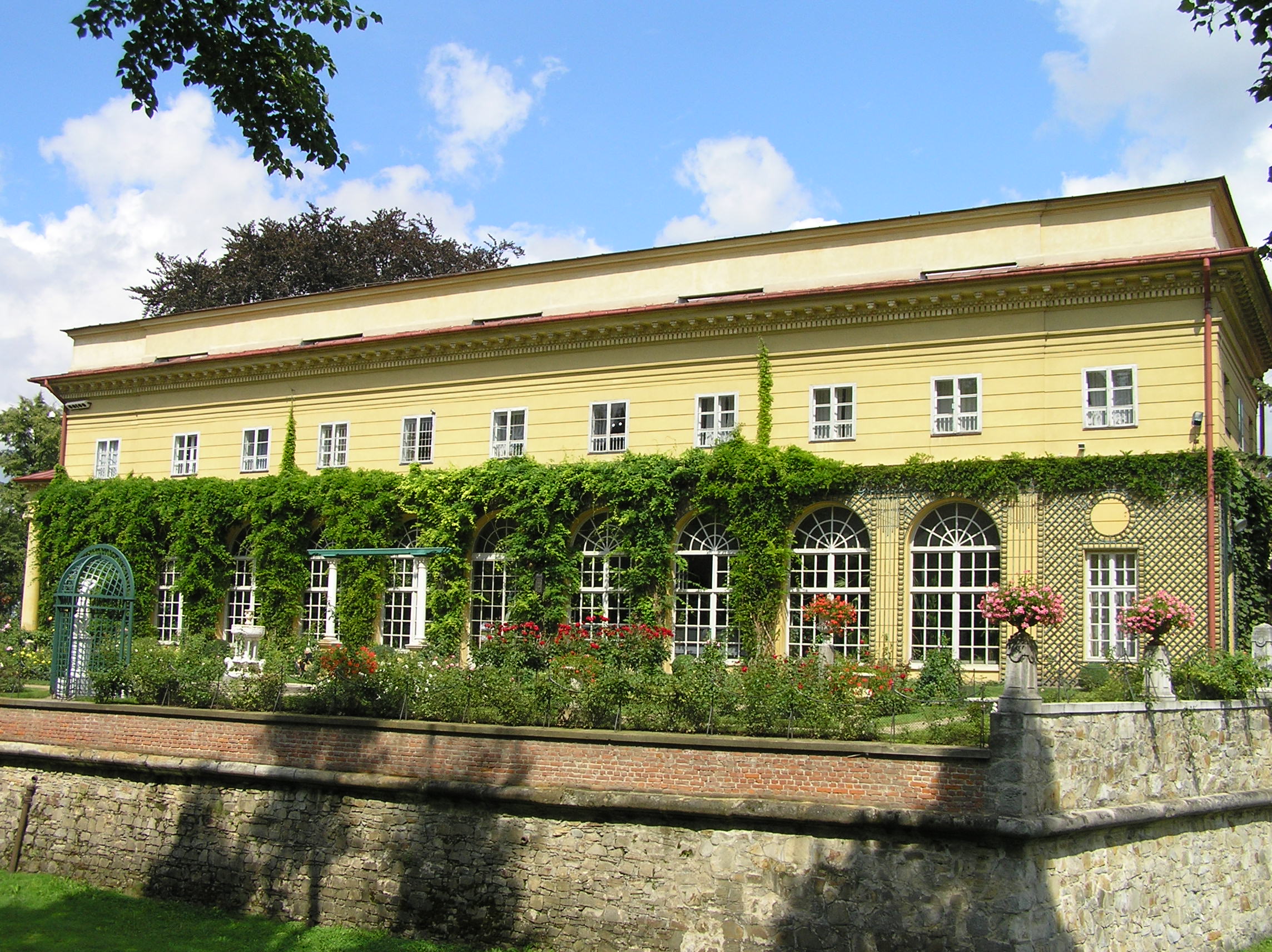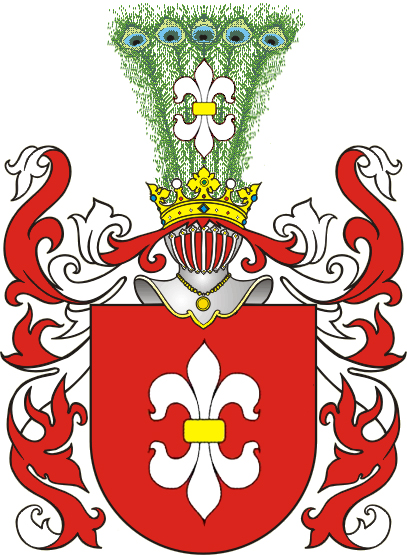|
Czartoryski Coat Of Arms
The Czartoryski coat of arms is a Polish–Lithuanian coat of arms, a variant of the Pogoń Litewska arms. It has been used by the Gediminid Czartoryski family. History Blazon There arms are a modified version of Pogoń Litewska, with three towers added at the lower part and the rest remaining identical. Notable bearers Notable bearers of this coat of arms include: * House of Czartoryski ** Adam Jerzy Czartoryski ** Adam Kazimierz Czartoryski ** August Aleksander Czartoryski ** Antonina Czartoryska ** Michal Fryderyk Czartoryski ** Konstancja Czartoryska ** Elzbieta Czartoryska ** Kazimierz Czartoryski ** Konstanty Adam Czartoryski ** Władysław Czartoryski ** Tamara Laura Czartoryska * House of Sanguszko See also * Polish heraldry * Heraldic family * List of Polish nobility coats of arms Gallery file:Pilawa (Potocki count) and Czartoryski (prince) CoA in Lancut palace.jpg, Pilawa coat of arms and the Prices Czartoryski coat of arms in Łańcut Castle ... [...More Info...] [...Related Items...] OR: [Wikipedia] [Google] [Baidu] |
Konstancja Czartoryska (1700–1759)
200px, Stanisław and Konstancja Poniatowski Princess Konstancja Czartoryska (ca. 1696 or 29 January 1700 – 27 October 1759) was a Polish-Lithuanian noblewoman and the mother of King Stanisław August Poniatowski. She played a political role as a driving force within the Familia (political party). Life She was the daughter of magnate Prince Kazimierz Czartoryski and his wife, Izabela Elżbieta Morsztyn. She was given a fashionable French-influenced education. She married Stanisław Poniatowski on 14 September 1720. The marriage was arranged by the assistance of Jakub Henryk Flemming as an alliance between the Poniatowski and Czartoryski family. After marriage, she frequently attended the royal court. Konstancja Czartoryska came to acquire a great influence within the family and be described as a driving force behind the political career of her spouse and her brothers. Through the connections she made at court, she could benefit the career of her brothers. She repo ... [...More Info...] [...Related Items...] OR: [Wikipedia] [Google] [Baidu] |
Łańcut Castle
Łańcut Castle is a complex of historical buildings located in Łańcut, Poland. Historically the residence of the Pilecki, Lubomirski and Potocki families, the complex includes a number of buildings and is surrounded by a park. The castle is one of Poland's official national Historic Monuments (''Pomnik historii''), as designated September 1, 2005, and tracked by the National Heritage Board of Poland. Owners In the second half of the 14th century, the land was the property of the Toporczyk family, who built a wooden castle on the hill. In the 16th century the castle belonged to Stadnicki family. Since the 17th century, the property was in the hands of the Lubomirski family, and then the Potocki family until 1944. History The castle was originally built in the second half of the 16th century, but was later modernised into a palace-residence by its owners. It was once home to two greatest Polish families – first, until 1816, the Lubomirski family, and later – until 1944 – ... [...More Info...] [...Related Items...] OR: [Wikipedia] [Google] [Baidu] |
Pilawa Coat Of Arms
Pilawa () is a Polish coat of arms. It was used by many noble families known as '' szlachta'' in Polish in medieval Poland and later under the Polish–Lithuanian Commonwealth, branches of the original medieval Piława Clan (''Pilawici'') family as well as families connected with the Clan by adoption. History The progenitor of the Pilawa Clan was supposed to have been Żyrosław z Potoka, who was fighting the Prussians, a pagan tribe and brought himself glory in the Battle of Piława, where he fought along Bolesław IV the Curly. The legend states that Żyrosław reached the pagan chief, fought him in hand-to-hand combat and killed him. The terrified enemy hordes fled the battle field. The related legend tells also that in 1166, to commemorate the victory, Bolesław IV bestowed a coat of arms upon Żyrosław, naming it for the place, where the battle took place. Blazon The Pilawa coat of arms assumed its final form in the late 14th century. Formerly, there were two differing ... [...More Info...] [...Related Items...] OR: [Wikipedia] [Google] [Baidu] |
List Of Polish Nobility Coats Of Arms
A ''list'' is any set of items in a row. List or lists may also refer to: People * List (surname) Organizations * List College, an undergraduate division of the Jewish Theological Seminary of America * SC Germania List, German rugby union club Other uses * Angle of list, the leaning to either port or starboard of a ship * List (information), an ordered collection of pieces of information ** List (abstract data type), a method to organize data in computer science * List on Sylt, previously called List, the northernmost village in Germany, on the island of Sylt * ''List'', an alternative term for ''roll'' in flight dynamics * To ''list'' a building, etc., in the UK it means to designate it a listed building that may not be altered without permission * Lists (jousting), the barriers used to designate the tournament area where medieval knights jousted * ''The Book of Lists'', an American series of books with unusual lists See also * The List (other) * Listing (di ... [...More Info...] [...Related Items...] OR: [Wikipedia] [Google] [Baidu] |
Heraldic Family
A heraldic clan (''ród herbowy''), in Poland, comprised all the noble (''szlachta'') bearers of the same coat of arms. The members of a heraldic clan were not necessarily linked by consanguinity. The concept was unique to Polish heraldry. History The Polish word ''herb'' derives from the German ''Erbe'', "inheritance" or "heritage", and denotes a coat of arms. Unrelated families could be granted the same coat of arms and thus become co-armigers sharing the same ''herb''. Bearers of the same coat of arms were variously called ''herbowni'', ''współherbowni'' (co-armorials), or ''klejnotni'', from ''klejnot'', "jewel". The numbers of such individual families often reached several dozen; several hundred were not uncommon. The heraldic-family tradition constitutes one of the hypotheses about the origins of the Polish nobility: the unique feature of Polish heraldry being the practice of inducting unrelated families into the same coat of arms, sometimes with minor variations of ... [...More Info...] [...Related Items...] OR: [Wikipedia] [Google] [Baidu] |
House Of Sanguszko
150px, Paweł Karol Sanguszko 150px, Dymitr Sanguszko 150px, Roman Sanguszko 150px, Janusz Sanguszko 150px, Hieronim Sanguszko 150px, Barbara Sanguszko née Dunin 150px, Eustachy Erazm Sanguszko 150px, Władysław Hieronim Sanguszko 150px, Eustachy Stanisław Sanguszko The House of Sanguszko ( be, Сангушка, ua, Санґушко, rue, Санґушко) is a Polish and Lithuanian noble and aristocratic family of Lithuanian and Ruthenian origin, connected to the Gediminid dynasty. Like other princely houses of Polish–Lithuanian Commonwealth, its origins are considered murky. Present historical opinion holds in favour of their descent from Algirdas' grandson Alexander (''fl.'' 1433–1443), lord of Kovel and Liuboml, whose name can be shortened to ''Sangush''. The family supposedly descends from two lines, associated with two of his sons, Alexander and Michael. The senior line, called the ''Sanguszko-Koszyrski'', has been extinct since the death of Adam Aleksan ... [...More Info...] [...Related Items...] OR: [Wikipedia] [Google] [Baidu] |
Tamara Laura Czartoryska
Princess Tamara Laura Czartoryska (Spanish: Tamara Laura María de los Dolores Luisa Fernanda Victoria y Todos los Santos Czartoryski y Picciotto; born 23 April 1978) is a Polish-Spanish former model, television star, and aristocrat. She is the daughter of Prince Adam Czartoryski y Borbón, first cousin to King Juan Carlos I of Spain. Family and upbringing Her mother, Nora Picciotto, was born in Cairo, worked as a public relations consultant in the film industry, and married her father in London. Her parents separated and divorced before she was seven years old. She did poorly at the Sacred Heart all girls boarding school in Woldingham, except in drama, due to her being rebellious and fond of pranks. When she was 15, she attended a tutorial college in Oxford for A-levels. After her father suffered financial reverses when Lloyd's of London crashed, expensive pastimes such as riding stopped. That, and her mother's break-up with a stepfather of whom she was fond, left her con ... [...More Info...] [...Related Items...] OR: [Wikipedia] [Google] [Baidu] |
Władysław Czartoryski
Prince Władysław (Ladislaus) Czartoryski (3 July 1828 – 23 June 1894) was a Polish noble, political activist in exile, collector of art, and founder of the Czartoryski Museum in Kraków. Life Son of Prince Adam Jerzy Czartoryski and Princess Anna Zofia Sapieha, he married María Amparo Muñoz, 1st Countess of Vista Alegre, daughter of Queen Maria Christina of Spain by morganatic marriage to Agustín Fernando Muñoz, Duke of Riánsares, on 1 March 1855 in Malmaison near Paris. Their son August Czartoryski contracted tuberculosis at the age of six from his mother, who died soon thereafter. August (known as "Gucio") had as a tutor Joseph (later Saint Raphael) Kalinowski. Władysław hoped that his son would pursue a diplomatic career, but Gucio went against his father's wishes and joined the religious order of the Salesians. Gucio was ordained a priest in 1893, but neither his father nor anyone else in the family attended the ceremony, and he died a year later of tu ... [...More Info...] [...Related Items...] OR: [Wikipedia] [Google] [Baidu] |
Konstanty Adam Czartoryski
Prince Konstanty Adam Czartoryski (October 28, 1777 – April 24, 1866) was a Polish szlachcic, nobleman who became colonel in 1809 in the Duchy of Warsaw and brigadier general in 1815 in Congress Poland. 1774 births 1860 deaths Polish generals Czartoryski family, Konstanky Adam Polish people of German descent Polish commanders of the Napoleonic Wars {{Poland-noble-stub ... [...More Info...] [...Related Items...] OR: [Wikipedia] [Google] [Baidu] |
Kazimierz Czartoryski
Prince Kazimierz Czartoryski (4 March 1674 – 31 August 1741) was a Polish nobleman, Duke of Klewań and . Kazimierz became Podczaszy of Lithuania since 1699, Grand Treasurer of Lithuania in 1707–1709, nominated by King Stanisław Leszczyński. He was also Deputy Chancellor of Lithuania in 1712–1724. Castellan of Vilnius since 1724 and starost of Krzemieniec, Wieliż and Uświaty. He founded the " Familia" during the interregnum in 1696–1699. He supported the candidature of François Louis, Prince of Conti for the Polish throne in 1697. Family In 1693 he married Izabela Morsztyn, daughter of Jan Andrzej Morsztyn and Katarzyna Gordon. They had three sons and two daughters. * Michał Fryderyk (1696-1775), Duke of Klewań and Żuków * August Aleksander (1697-1782), father of Adam Kazimierz Czartoryski * Konstancja (1700-1759), mother of King Stanisława Augusta Poniatowskiego * Ludwika Elżbieta (1703-1745) * Teodor Kazimierz (1704-1768), bishop ... [...More Info...] [...Related Items...] OR: [Wikipedia] [Google] [Baidu] |
Elżbieta Czartoryska (1736–1816)
{{Hndis, Czartoryska, Elzbieta ...
There have been two Polish noblewomen named Elzbieta Czartoryska: *Elżbieta Czartoryska (1736–1816) *Elżbieta Czartoryska (1905–1989) Count Stefan Adam Zamoyski (17 February 1904 – 27 October 1976) was a Polish nobleman, landowner, and magnate. Stefan had a degree of Doctor of Law. He was owner of estates in Wysock. Lt.-Col. Count Stefan Zamoyski served as an aide-de-ca ... [...More Info...] [...Related Items...] OR: [Wikipedia] [Google] [Baidu] |

